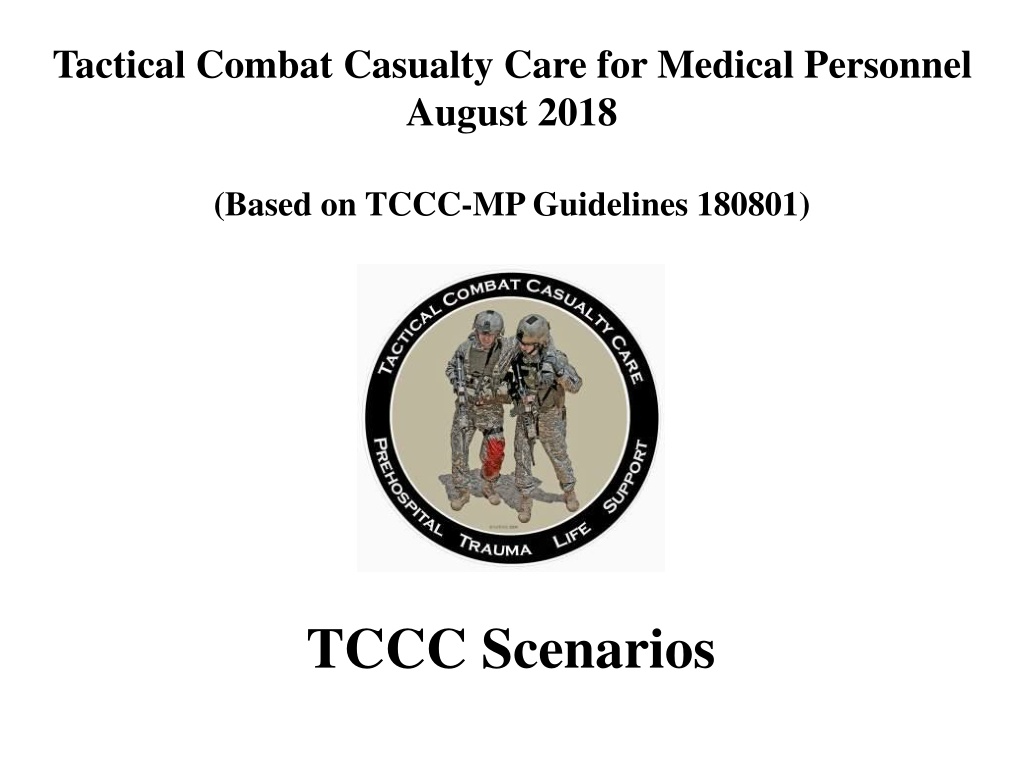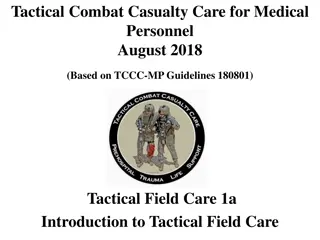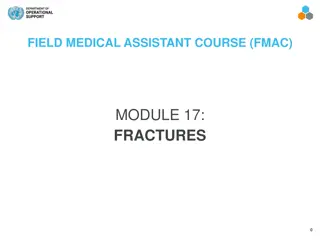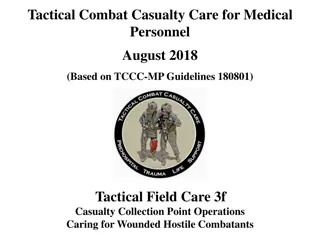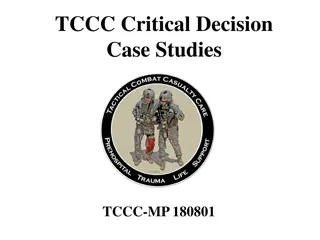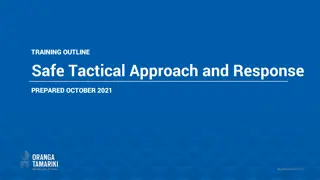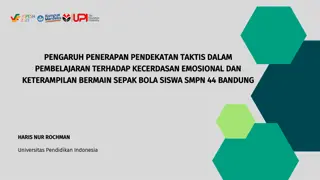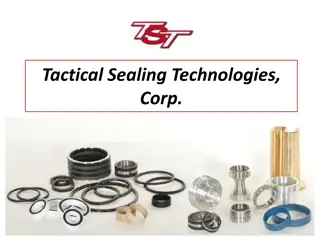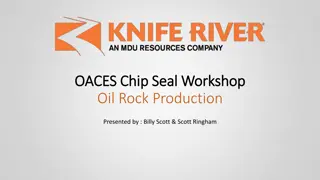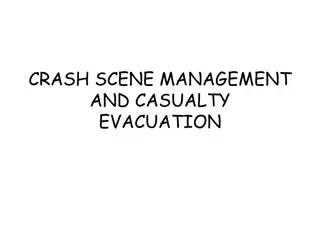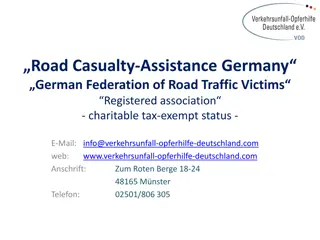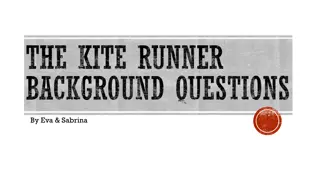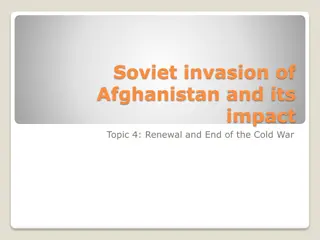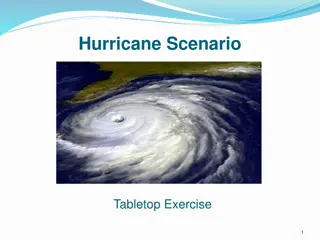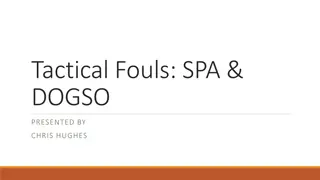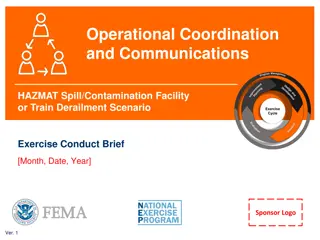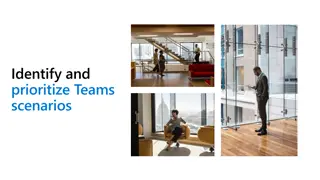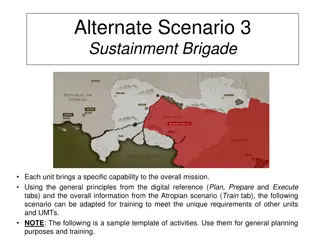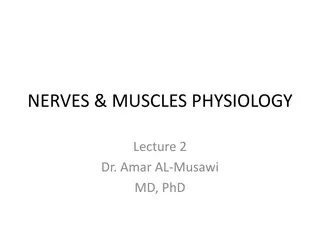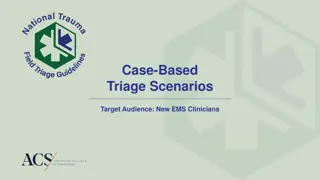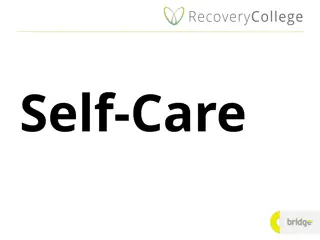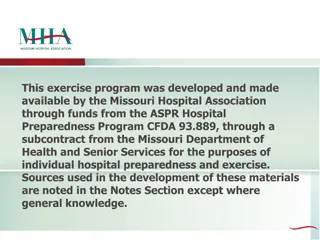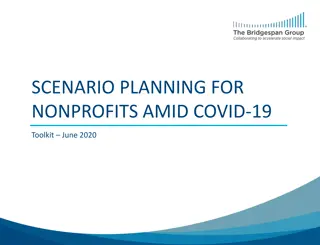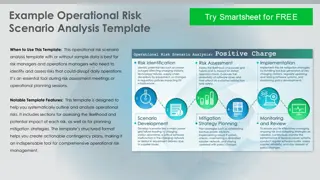Tactical Combat Casualty Care in Action: SEAL Casualty Scenario in Afghanistan
Experience real-life combat trauma management in action through a SEAL casualty scenario in Afghanistan. Follow the first responder's account of assessing and treating a teammate with severe injuries, highlighting the challenges and critical decisions made in the field.
Download Presentation

Please find below an Image/Link to download the presentation.
The content on the website is provided AS IS for your information and personal use only. It may not be sold, licensed, or shared on other websites without obtaining consent from the author. Download presentation by click this link. If you encounter any issues during the download, it is possible that the publisher has removed the file from their server.
E N D
Presentation Transcript
Tactical Combat Casualty Care for Medical Personnel August 2018 (Based on TCCC-MP Guidelines 180801) TCCC Scenarios
Disclaimer The opinions or assertions contained herein are the private views of the authors and are not to be construed as official or as reflecting the views of the Departments of the Army, Air Force, Navy or the Department of Defense. - There are no conflict of interest disclosures.
Learning Objective APPLYyour knowledge of TCCC to selected tactical scenarios.
Tactical Casualty Scenarios If the basic TCCC combat trauma management plan doesn t work for the specific tactical situation, then for combat medics, corpsmen, and PJs it doesn t work. There are no rigid guidelines for combat tactics THINK ON YOUR FEET. Scenario-based planning is critical for success in TCCC Examples to follow:
SEAL Casualty - Afghanistan August 2002 Somewhere in Afghanistan SEAL element on direct action mission Story of the casualty as described by the first responder NOT a corpsman
SEAL Casualty - Afghanistan There were four people in my team, two had been shot. Myself and the other uninjured teammate low crawled to the downed men. The man I came to was lying on his back, conscious, with his left leg pinned awkwardly beneath him. He was alert and oriented to person, place, time, and event. At that point I radioed C2 (mission control) to notify them of the downed man.
SEAL Casualty - Afghanistan Upon closer inspection, his knee was as big as a basketball and his femur had broken. The patient was in extreme pain and did not allow me to do a sweep of his injured leg. He would literally shove me or grab me whenever I touched his leg or wounds. I needed to find the entrance and exit wound and stop any possible arterial bleeding.
SEAL Casualty - Afghanistan But there was zero illumination and he was lying in a wet irrigation ditch. So I couldn t see blood and I couldn t feel for blood.
SEAL Casualty - Afghanistan We were also in danger because our position was in an open field (where the firefight had been) and I had to provide security for him and myself. So, I couldn t afford to turn on any kind of light to examine his wounds. I told him to point to where he felt the pain. He had to sort through his pains.
SEAL Casualty - Afghanistan He had extreme pain in his knee and where his femur had been shattered as well as a hematoma at the site of the entrance wound (interior and upper left thigh). Finally, he pointed to his exit wound (anterior and upper left thigh). Again, I had no way of telling how much blood he had lost. But I did know that he was nonambulatory.
SEAL Casualty - Afghanistan So I called C2 again. I gave him the disposition of the patient as well as a request for casevac, a Corpsman, and additional personnel to secure my position and assist in moving the patient to the helicopter. I thought about moving the two of us to some concealment 25 meters away, but we were both really low in a shallow irrigation ditch. I felt safer there than trying to drag or carry a screaming man to concealment.
SEAL Casualty - Afghanistan Between providing security and spending a lot of time on the radio I didn t get to treat the patient as much as I wanted to. I had given him a Kerlix bandage to hold against his exit wound. When he frantically told me that he was feeling a lot of blood, I went back to trying to treat him. I couldn t elevate his leg. To move it would mean he d scream in pain, which wasn t tactical.
SEAL Casualty - Afghanistan There was just no way he would allow me to apply a pressure dressing to the exit wound even if I could locate it and pack it with Kerlix. So, I decided to put a tourniquet on him.
SEAL Casualty - Afghanistan His wounds were just low enough on his leg to get the tourniquet an inch or so above the site. I had a cravat and a wooden dowel with 550 cord (parachute cord) attached to it to use as a tourniquet. I told him to expect a lot of pain as I would be tightening the cravat down.
SEAL Casualty - Afghanistan At this point he feared for his life so he agreed. Once I got it tightened I had trouble securing it. The 550 cord was hard to get underneath the tightened cravat.
SEAL Casualty - Afghanistan After over 5 minutes, the Corpsman arrived along with a CASEVAC bird and a security force. Moving the patient was very hard. Four of us struggled to move him and his gear 25 meters to the bird. The patient was over 200 pounds alone and we were moving over very uneven terrain.
SEAL Casualty - Afghanistan We wanted to do a three-man carry with two men under his arms and one under his legs. But again, his leg was flopping around at the thigh and couldn t be used to lift him.
SEAL Casualty - Afghanistan The bird, (a Task Force 160 MH-60) had a 50-cal sniper rifle strapped down, which made it hard for us to get him in. It took us minutes to get him 25 meters into the bird. The Corpsman went with my patient as well as the other downed man in my team and I went back to the op.
Scenario Discussions Suggested Format Break up into groups of six Present the background for the scenario on the screen. The Instructor will lead the group s discussion through to the end of the scenario. Instructor should have a printout of the speaker notes to lead the session. 10 minutes per scenario Stop after 10 minutes and present next scenario on screen
Urban Warfare Scenario
Real-World Scenario High-threat urban environment 16-man Ranger team 70-foot fast rope insertion for building assault One man misses rope and falls Unconscious on the ground Bleeding from mouth and ears Unit taking sporadic fire from all directions from hostile crowds
The Battle of Mogadishu Somalia Oct 1993 US casualties 18 dead, 73 wounded Estimated Somali casualties 350 dead, 500 wounded Battle 15 hours in length
Mogadishu: Complicating Factors Helo CASEVAC not possible because of crowds, narrow streets and RPGs Vehicle CASEVAC not possible initially because of ambushes, roadblocks, and RPGs Gunfire support problems Somali crowds included non-combatants Somalis able to take cover in buildings RPG threat to helo fire-support gunships
Care Under Fire Return fire? Move patient to cover right away or wait for long board? How should he be moved? Intubation? IV fluids? Urgency for evacuation?
Mogadishu Scenario 2 Helo Hit by RPG Round
Mogadishu Scenario 2 Helo Hit by RPG Round Hostile and well-armed (AK-47s, RPGs) crowds in an urban environment. Building assault to capture members of a hostile clan. Blackhawk helicopter trying to cover helo crash site. Flying at an altitude of 300 feet.
Mogadishu Scenario 2 Helo Hit by RPG Round Left door gunner with 6-barrel M-134 minigun (4000 rpm) Hit in left hand by ground fire Another crew member takes over mini-gun RPG round impacts under right door gunner
Mogadishu Scenario 2 Helo Hit by RPG Round Windshields are all blown out Smoke is filling the aircraft Right minigun is not functioning Left minigun is without a gunner and is firing uncontrolled Pilot: Transiently unconscious - now becoming alert
Mogadishu Scenario 2 Helo Hit by RPG Round Co-pilot Unconscious - lying forward on the helo s controls Crew Member Right leg blown off above the knee Lying in puddle of his own blood Pulsatile bleeding from the stump
Mogadishu Scenario 2 Helo Hit by RPG Round YOU are the person providing care in the helo. What do you do first?
Mogadishu Scenario 2 Helo Hit by RPG Round Who gets treated first? Take care of the pilot first. You want to get him back to flying the aircraft. The most important thing about medical care in an aircraft is to keep the aircraft in the air. Stimulate the pilot by shaking him or performing a sternal rub.
Mogadishu Scenario 2 Helo Hit by RPG Round Who s next? The casualty with the femoral bleeder is next. He needs a tourniquet. He should be able to provide self-care if he s conscious. The individual in Mogadishu treated himself. He used an improvised tourniquet. He survived.
Mogadishu Scenario 2 Helo Hit by RPG Round What can you do for the unconscious co- pilot? First, get him off the controls. Get him into a supine position. Establish an airway with an NPA. Check for external bleeding. You see none.
Mogadishu Scenario 2 Helo Hit by RPG Round Next action? Check the casualty with the hand injury. Stop any severe bleeding.
Mogadishu Scenario 2 Helo Hit by RPG Round What else? Radio for help. Prepare for impact if a crash landing is anticipated. After impact secure weapons and ordnance.
Mogadishu Scenario 2 Helo Hit by RPG Round End of Scenario
MOUT Scenario 1 A U.S. ground element is moving on a high- value target in an urban environment. The first two men in a 8-man patrol are shot by an individual with an automatic weapon while moving down a hallway in a building. The attacker follows this burst with a grenade.
MOUT Scenario 1 One casualty is shot in the abdomen but is conscious. The second casualty is shot in the shoulder with severe external bleeding. A third person is unconscious. The attacker withdraws around a corner.
MOUT Scenario 1 YOU are the person providing medical care. What do you do?
MOUT Scenario 1 What are the tactical considerations here? How many other hostiles are in the house? Should everyone pursue the hostile(s) and leave care of the casualties for later? Should the whole unit withdraw to care for casualties? Should the unit set security and treat the casualties there? Should the unit split up and have some pursue and others treat? Splitting the force is most often chosen by previous groups as the best option. So, you are left with the casualties to proceed with care as per Tactical Field Care Guidelines.
MOUT Scenario 1 Who gets treated first? The casualty with the shoulder injury and massive external bleeding. He s the most important to treat immediately he could bleed to death quickly. What do you do for him? Stop the bleeding with XStat. The wound has a deep, narrow tract. XStat doesn t require 3 minutes of manual pressure. Bleeding is controlled Casualty is alert.
MOUT Scenario 1 Casualty with shoulder injury: what next? Airway Management? He s conscious and breathing OK. Respirations? He s breathing OK. O2 sat is 95%. Beware of the risk for tension pneumothorax. IV? Not yet. He s not in shock at the moment. You have controlled the bleeding.
MOUT Scenario 1 Casualty with shoulder injury: what else? Combat Wound Medication Pack? Yes. Pain is becoming increasingly severe. Should you give fentanyl? Careful he may go into shock later due to bleeding from the shoulder wound. Ketamine is a better choice here.
MOUT Scenario 1 Who s next? Unconscious Casualty He has no penetrating head trauma. What do you do first? Check for massive hemorrhage You find major bleeding in back of one thigh from a shrapnel wound. Treatment? Apply a limb tourniquet.
MOUT Scenario 1 Unconscious casualty: What else? Airway Management Chin-lift/jaw thrust NP airway Next? Check pulse and respirations You find a rapid, thready pulse and rapid respirations. You attach a pulse oximeter O2 sat is 95%
MOUT Scenario 1 Unconscious casualty: Next? Circulation Pelvic binder? Maybe when you have taken care of the last casualty. Pelvic fracture is unusual following isolated hand grenade blasts. Obtain IV/IO access Administer 1 gm TXA over 10 minutes Initiate fluid resuscitation with whole blood Hypothermia prevention
MOUT Scenario 1 Unconscious casualty: Next? Analgesia? None required since he s unconscious. Antibiotics? Yes IV Ertapenem Have someone else check for other injuries: There are none.
MOUT Scenario 1 Conscious casualty with abdominal GSW is last. What do you do? Check for massive hemorrhage Minimal oozing from abdominal GSW No exit wound Airway Management? He s conscious and breathing OK. His radial pulse is strong.
MOUT Scenario 1 Conscious casualty with abdominal GSW: Next? Does he need IV access? Yes he s at significant risk for developing hemorrhagic shock. TXA? Yes. He s at significant risk of shock due to uncontrolled hemorrhage secondary to abdominal GSW.
